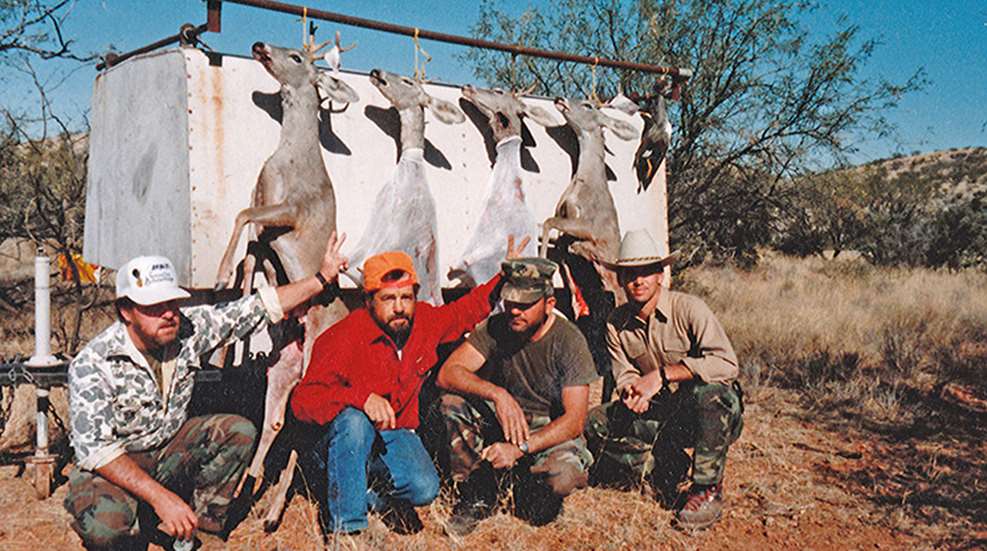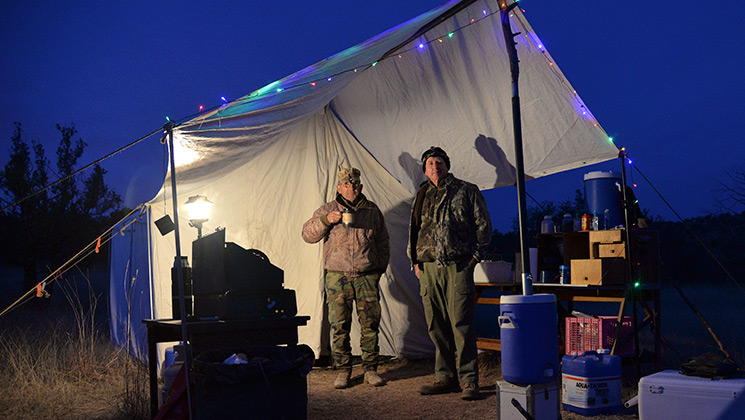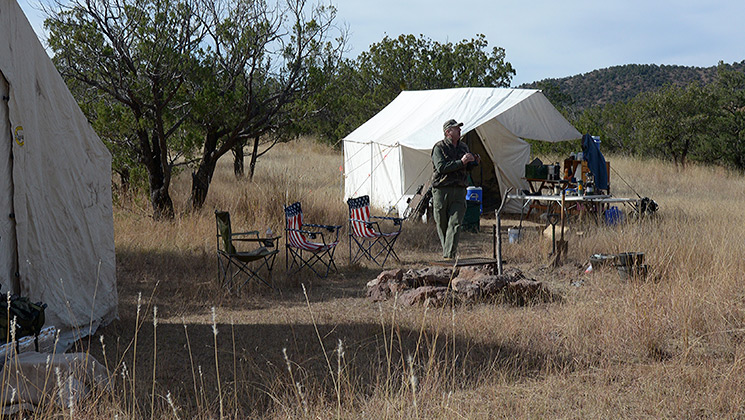
You know you’re in a well-drilled deer camp when its four members barely speak while converting a bare piece of national forest into a fully rigged, tightly organized headquarters within three hours of dropping their trucks’ tailgates.
Of course, it helps that three of them served together in the Marine Corps, and the fourth married the Lieutenant Colonel’s daughter. Other than sizing up and sharing thoughts on the best sites for their canvas wall tents, the men’s shared deer-camp history spares them any debates over where to build the fire pit, stack firewood, arrange chairs and set up the Colonel’s kitchen, which includes a homemade chuck and its sturdy stand.
Although their annual deer camp might vary by time and GPS coordinates, its layout and design remains fairly constant wherever they park in southern Arizona’s Coronado National Forest. That’s because a good deer camp is functional and supportive, which means consistent yet adaptable to each situation. Yes, it’s also comfortable, but comfort isn’t their objective. They’re here to hunt the Coues whitetail, a small, wary, graceful creature that slips through the oaks and piñons of these arid mountains like wispy morning fog.
The camp’s two senior members, Sgt. Maj. Bill Brandt of Tucson and Lt. Col. Ron “Hawkeye” Pearce of Yuma, have hunted together since 1983, except for years when the Marine Corps sent them in opposite directions. In 1997 they admitted their third member, Col. Dan “Reddog” Karls, to their camp when previous members such as John McCullam, Kenny Sayner and Dick Arsonall faded from the picture. More recently they also brought in Pearce’s son-in-law, Robert M. Lee of Goodyear, Ariz., to round out their four-man group application.
When they arrive each fall, bouncing their trucks along old rock-strewn roads blazed by 19th-century silver miners, they shrug while driving past hunters who’ve beaten them to previous campsites. No worries. Most camps shut down soon after opening weekend, at which time the deer resume moving more freely. And when that happens, the retired Marines will be ready. As always, they’ll walk a little farther than most, and stay as long as their rifle-hunting license allows.
Puzzle Pieces
“We never know which campsite we’ll use, but we know the prevailing winds and where they’ll blow our campfire’s smoke, so we’ll look at the site and set up: boom, boom, boom,” Pearce says. “It’s second nature. If I pull out the tape to measure something, someone grabs the end without asking. It’s just practice and muscle memory. We each have a piece to the puzzle and we know where every piece belongs.
“We built each table for a specific purpose,” Pearce continues. “We know where the burner needs to be for making coffee, and which tabletop holds Dan’s cooking gear. He might move it a few feet after we step away, but that same table goes with those same items one camp to the next.”
Their synchronized system is actually a year-round process of endless evaluation and modification. When they break camp and head home, they’ll sort and clean everything before storing it for next year, and dedicate individual boxes for storage so they don’t have to search for anything 11 months later. Brandt, in fact, once built a trailer and basically kept it packed year-round so they were ready to go at a moment’s notice.
They are Marines, after all, and that can never change. As Karls notes, they don’t just know the puzzle pieces and where each piece belongs. Sometimes they are the puzzle pieces because each man plays a specific role. He recalls how he won his role as camp cook.
“When Ron and I were in Yuma back in the ’90s, a bunch of us at the O club always listened to his hunting stories,” Karls says. “We had all grown up hunting mule deer or Eastern whitetails, but we each wanted that Coues deer experience. I realized we were all competing for one spot, and I had to figure out how to get it. I’ve shot my share of deer over the years, but I didn’t have the trophies those other guys had. So when they laid all their big-buck photos on the bar one night to impress Hawkeye, I was ready. I brought out all my favorite recipes for my Dutch ovens, slapped them down alongside those trophy bucks and told Ron, ‘Bring me along, and this is what you’ll be eating in camp.’
“I don’t think he and Sergeant Major thought twice about those other guys after that. Ron and he are as good as it gets when it comes to hunting Coues deer. Their camp didn’t need another ‘professional’ hunter. They needed someone with other skills and tools.”
Pearce remembers that incident, but jokes that he and Brandt valued another of Karls’ skills even more: “We made him part of the camp because he likes doing dishes,” Pearce says. “Sergeant Major and I know how to cook.”
Brandt laughs, but agrees that Karls’ cooking adds a unique element to their camp. “Ron used to bring a wok and we ate well, but when he invited Daniel to come along with his Dutch ovens that was a profound change—the biggest since the advent of Christianity,” Brandt says. “Daniel puts a lot of thought and planning into our meals.”

Dutch Oven Maestro
All joking aside, Pearce says he and Brandt respect Karls’ expertise in the kitchen. “He’s so proud of his Dutch ovens that we had no choice but to invite him back after his ‘tryout’ the first year,” says Pearce. “He fell right into the group. Everyone liked his cooking. He would save his menu and ask which recipes made the cut for next year, and then he’d add new ones to impress us. He won’t let anyone touch his Dutch ovens. He took over our evening dinners and never gave them back.”
Karls appreciates the praise, but says he’s just filling his role. “I like being out here,” he says. “Even when I hunt, I sometimes just put my rifle on my shoulder and hike around the mountains. I’m not surprised if I don’t see a deer. I can’t find the deer that’s the most hidden the way Ron and the Sergeant Major do. I’m better at the cooking and cleaning. If I’m going to serve the team, that’s what I do best.”
Karls rolls out of his rack each morning an hour before the others stir, and quietly fires up his kitchen to brew coffee and cook breakfast. He’s also the last one to turn in each night after preparing his kitchen for its dawn duties. For evening meals, he chooses recipes that take less than a half-hour of preparation and an hour of cooking.
“I studied Redbook and Ladies Home Journal because their recipes help busy housewives quickly feed their families after they get home from work,” says Karls. “That’s what you’re looking for in deer camp. When guys get back in from hunting, they don’t want to wait all night to eat, and I don’t want them worrying about their food. They’re our camp’s best hunters, so I do what I can so they get the most out of their time up here.”
Two Basic Rules
That same “keep it simple” approach is also evident in the camp’s rules. Unlike some deer camps that have everything from 10 commandments to bylaws and 10-year contracts, this camp has only two basic rules: 1) Always keep your rifle pointed in a safe direction; 2) If you shove off for home before the others, take all the garbage but leave your water and ice.
“Those rules illustrate that you can basically do anything you want except endanger your fellow hunters,” says Karls. “You respect your weapon, and you never forget the value of water and ice out here. Other than that, enjoy the experience. You get what you want out of it, and you hunt however you want. Sergeant Major doesn’t like sitting all day at an OP [observation post], so he’ll hunt alone down in the oak bottoms at close range. But Hawkeye, he works those OPs up there better than anyone. He looks under every bush and tree, and checks them again as the sun moves and changes the lighting and shadows.”
By “up there” Karls means the Coronado National Forest’s peaks and mountainsides, which range in elevation from about 4,000 feet at the base to about 9,450 feet at the highest summits. The camp’s members admire this region and its wildlife.
In fact, hunting Coues deer in such country seems tailor-made for Marines. After all, they’re schooled in reading maps, analyzing terrain, adapting to weather extremes, “acquiring targets” at long range and crafting strategies to put someone into rifle range.
“That makes sense,” Karls agrees. “For Marines, everything is about the infantrymen. We can be pilots, artillerymen or a bunch of other specialties, but they all exist to support that 18-year-old with a rifle. That’s their focus. They all use their position, the terrain and their powers of vision from an observation post to enable the group’s mission. We might not put it in those terms, but that’s what you see with this deer hunt.”
Pearce says everyone in the camp owns a GPS unit, but they still prefer studying and interpreting intervals on a topo map. That’s partly because the region’s hills and mountains are covered in piñon, juniper, desert-dwelling oaks and other trees seldom taller than 15 feet. Therefore, with just a few steps you’re usually in an opening with a direct visual to camp.
For Pearce’s money, nothing equals a Coues deer hunt, especially when they spot a buck worth stalking and coordinate a two-man hunt. “A full day of spotting and stalking … that can be a lot of fun,” he says. “Unfortunately, you usually don’t see many bucks you want to stalk. But when you do, you have to act fast to get a chance at them. Sometimes you move in on a bedded buck and wait till they stand up in the afternoon. Other times you try to intercept them on the run. But most hunts are hours and days of sitting and glassing, interrupted by a few seconds of chaos.”

High Standards
In other words, this deer camp sets high standards for bucks they’ll shoot. “It has to be a spectacular buck for us to shoot the first day, and we hold out for a mature buck until we pull out,” Pearce says. “When you wait all year for this hunt, you never want it to be over in a day. We let the little ones grow up, but we know they get tougher to kill the longer they live. Like the Sergeant Major says, it’s all fun and games for us, but for Coues deer it’s life and death 365 days a year. Something’s always trying to kill them.”
They also set high standards for their gear. When they started hunting Coues deer in the early 1980s, Brandt and Pearce used to walk nearly all day, and stop regularly to pitch rocks into thick brush and other likely hiding places to push deer into the open.
“Coues deer are probably the smartest deer on the continent,” Brandt says. “They’ll let you just walk by, or they’ll move out of your way and watch you from a distance. We watched a buck from far off one time get up as this guy approached. It moved around him, keeping a rocky knoll between itself and the hunter. That buck kept its ears pointed at the guy the entire time. Once the guy moved out of his area, the buck just laid back down.”
As Brandt and Pearce discovered how effective spot-and-stalk could be, they learned their old scopes and cheap binoculars were more hindrance than hand-tool.
“We’d get awful headaches some days from those binoculars,” Pearce says. “But every time you learn a better way to hunt, you’re modifying your stool, your tripod, the binocular’s mounting system … it never ends. That’s part of the fun. You’re always learning and adapting.”
What’s the most important piece of gear for hunting Coues deer? “A comfortable stool,” says Pearce. “The more time you can spend on your butt, the more deer you’ll see.”
But even that requires tinkering. “I shortened the legs on my portable stool so I can easily rest my elbows on my knees for extra stability,” he says. “If you look around the camp, very few of our things aren’t modified. Each year everyone is showing off what they bought or fabricated. We like sitting around and modifying things when we’re at home, and showing them off the next time we’re in camp. There’s some one-upmanship going on.”
And what is Sgt. Maj. Brandt mulling as he looks ahead to this fall’s deer camp?
“I saw the biggest buck I’ve ever seen east of camp right before we had to shove off last fall,” he says. “I couldn’t sleep that night, just thinking about him lunging up that hill. He had a huge rack. I ranged him at 802 yards. I’ve got a plan I’ve been working on, but it won’t be easy. There’s a reason 98 percent of that country never gets hunted.”
How much do you want to bet that percentage of un-hunted land drops this fall?




































